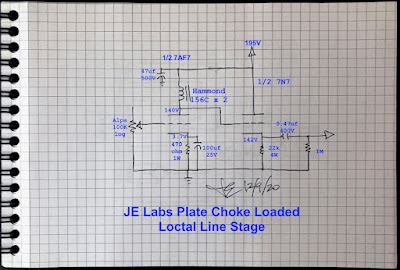I acquired this pair of James JS 4120N, 200H @ 15 mA nickel plate chokes from Keith Tan of Euphonia Audio in late '04. Due to my busy performing and teaching schedule back then, they remained boxed up close to two decades.
After going home with me to Manila and back stateside, I finally found time to try the JS 4120Ns in my preamp. After adjustment of voltages and operating points, I was impressed by the increased detail and resolution brought forth by replacing the Allen-Bradley plate load resistors while retaining the sonic aura I've come to treasure from my Bruce Berman-derived 76 > 1/2 6SN7 line stage circuit from Sound Practices Issue 13.
Unfortunately the JS 4120Ns have been out of production for quite a number of years. 😞
!!!WARNING!!!
The voltages in this project are potentially lethal! Proceed at your own risk!
 |
| NOTE: According to the 7N7 data sheet, it has a maximum cathode to heater (filament) voltage rating of 90V. To get around the 142V at the cathode, I lifted the filament potential 65V above ground via a voltage divider network in the B+ supply. Hence, 142 - 65 = 77, which brings it back to spec. |
 |
| 100 Hz, 1 kHz and 10 kHz square wave output from 2 x Hammond 156C plate choke loaded 1/2 7AF7 + 1/2 7N7 cathode follower |
I tried the budget-friendly Hammond 156C plate load chokes in the circuit above on my loctal preamp as well as on my main preamp with the 76 line stage below.
Detail improved but I missed the micro dynamics and organic quality in the midrange of the JS 4120Ns. That said, I'm now using this topology in the nosTDA1541tube DAC in my main hifi set up. Meanwhile the loctal preamp line stage has been reverted back to its original state with Allen-Bradleys.
 |
| NOTE: This choke saturates instantly past 8 mA! |
Since the Hammond 156Cs are easy on the wallet (just like the 125ESEs I wrote about decades ago😉), why not try and judge for yourself? If you hear potential, then proceed to the nickel plate choke-equipped circuit below.😊
 |
| Custom wound Intact Audio 250H nickel plate chokes |
I was so impressed with Dave's nickel plate chokes👏 such that I ordered a pair for myself so I could use the JS 4120Ns for other tubes and circuits. I also confirmed that in order to get the most out of the plate load choke topology, one needs a competent winder, and nickel should be part of the equation!
 |
| Even if I always used more rugged 6SN7 GTA and GTB types in the cathode follower section, when I built this preamp over two decades ago, the power supply was configured so that the filament potential was about 75V above ground. |
I've always admired the sound (or more appropriately, the lack thereof) of nickel permalloy, having owned the Tamura F7002 and Tango NY15S since the 90s. Even if these output transformers are hefty beasts, which helps the low frequencies, it's not their bass response that captivates the listener. Instead, they present a very natural midrange replete with rich and harmonious overtones, which are virtues I also hear with Finemet.
 |
| 100 Hz, 1 kHz and 10 kHz square wave output from an Intact Audio nickel plate choke loaded 76 + 1/2 6SN7 cathode follower |
After praising the merits of exotic core material, I wouldn’t want readers to get the impression that nickel or Finemet are the quintessential elements to great sound. Tube choice, circuit topology and operating points, parts selection, etc. not to mention the synergy of components in the hifi chain, all contribute to the sonic stew. That's why I encourage audio hobbyists to listen and experiment so that they can carve their path towards their own musical satisfaction.
Although this video is merely a proof of concept, I got inspired and used my Sony A7II + Voigtlander Ultron 28mm f1.9 LTM lens mounted on a tripod rather than my usual iPhone. So plug in your Koss Porta-Pros or Sennheiser HD6XXs and (hopefully) enjoy!🎶🎹🎻
Maybe 🤔 I'll talk about my plate choke adventures with SE amps next time!😉











.jpg)














































.jpg)